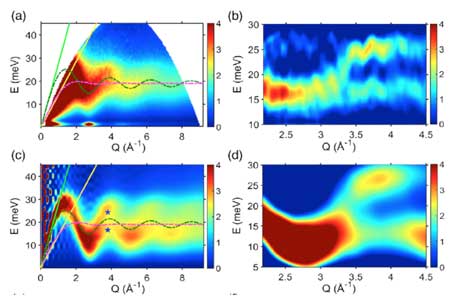| Aug 06, 2020 | |
High-frequency transverse phonons in amorphous materials observed for the first time(Nanowerk News) Understanding the microscopic origin of different physical properties of solids is of fundamental importance for condensed-matter physics and for materials applications. Yet, there is still a lot of unknowns in amorphous materials due to their disordered atomic structure. |
|
| Recently, with the state-of-the-art neutron scattering instrumentation and molecular dynamic simulations, an international research team, led by physicists from City University of Hong Kong (CityU), has demonstrated the existence of high-frequency transverse phonons in metallic glass for the first time. | |
| Their findings (Physical Review Letters, "Observation of High-Frequency Transverse Phonons in Metallic Glasses") also suggest that the atomic structure correlates with its atomic dynamics, providing new insight for understanding the atomic structure-dynamics relationship in disordered materials. | |
| In condensed-matter physics (the study of substances in their solid state), there are two main classes of solids based on their atomic arrangements: crystalline and amorphous solids. Atomic positions in crystalline solids exhibit a property called long-range order, meaning that the atomic positions repeat periodically. On the contrary, there is no long-range order in amorphous solids, also known as glass. | |
| This lack of long-range regularity makes it extremely difficult for scientists to determine details of atomic arrangement of amorphous materials with the structure-probing techniques which work so well for crystals. The phonon oscillation modes of amorphous materials are far more complicated and different from those in crystals, too. In fact, the prestigious journal Sciencehas identified the understanding of atomic structure and dynamics of glass structures as one of the 125 grand scientific challenges. | |
 |
|
| Fig 1: Atomic structure of crystalline solids, amorphous solids (glass structures) and gas. While both crystalline and amorphous solids exhibit short-range order, meaning that each atom has three nearest-neighbour atoms at the same distance, amorphous solids do not have long-range order. (Image: Britannica) | |
| Phonon is the quantum mechanical description of the atomic oscillation that move through the lattice at a given frequency. Just like waves, phonon vibrations can be separated into the transverse and longitudinal directions. The concept of phonons has helped to explain many physical properties of crystalline solids, such as thermal conductivity. But there is still a lot yet to be discovered for amorphous materials. | |
| “We know that longitudinal phonons exist everywhere, from solids, liquids, glass structures to gas. That’s why we can hear the sound. But for transverse phonons, since it is related to the shear of the materials, we only know they exist in crystalline solids. And not in gas, as we cannot shear the gas. But for amorphous materials and liquids, we are not sure,” said Professor Wang Xunli, Chair Professor and Head of Department of Physics at CityU, who is one of the leaders of this research to find out the nature of transverse phonons in amorphous materials. | |
| Longitudinal and transverse vibrations | |
| The team carried out inelastic neutron scattering (INS) experiments to measure the atomic dynamics in zirconium-copper-aluminium (Zr-Cu-Al) metallic glass, using the most advanced chopper spectrometer at the Spallation Neutron Source, Oak Ridge National Laboratory, USA. | |
| The team showed that, for the first time, transverse phonons exist at high-frequency in amorphous materials. This finding poses a challenge to the viewpoint that transverse phonons could only exist at low energies. Screenshot 2020-08-05 at 11.06.40 AM.png | |
 |
|
| To crosscheck their observation, the team ran a series of meticulous molecular dynamic simulations. Based on the molecular dynamic simulation results, they observed a correlation between the transverse phonon dynamics and the disordered structure in the testing of metallic glass. The apparent peak width of the transverse phonons follows the static structure factor (red dot curve synchronizes with the black curve in the upper graph in fig 4(a)). But no correlation was found for longitudinal phonons. Such correlation suggests that transverse phonons hold a key role in understanding the relationship between the atomic structure and atomic dynamics in amorphous materials. (© Phys. Rev. Let.) (click on image to enlarge) | |
| The team obtained similar results when running the simulation on a generic model glass. This finding strongly suggested that that the correlation is not unique in metallic glass, but universal for amorphous materials. | |
| “Due to the disordered atomic arrangement, the experimental study of the physical properties of amorphous materials has been very difficult. But thanks to the advance of the neutron scattering instrumentation, it provides us an opportunities to pursue the discoveries of amorphous materials,” said Professor Wang. | |
| “There are many theories and models on the structure and dynamics of liquids and glass. Our research findings can provide a new guideline for the future development of theories and models related to the structure-dynamics relationship in glassy materials,” said Professor Wang. |
| Source: City University of Hong Kong | |
|
Subscribe to a free copy of one of our daily Nanowerk Newsletter Email Digests with a compilation of all of the day's news. |
